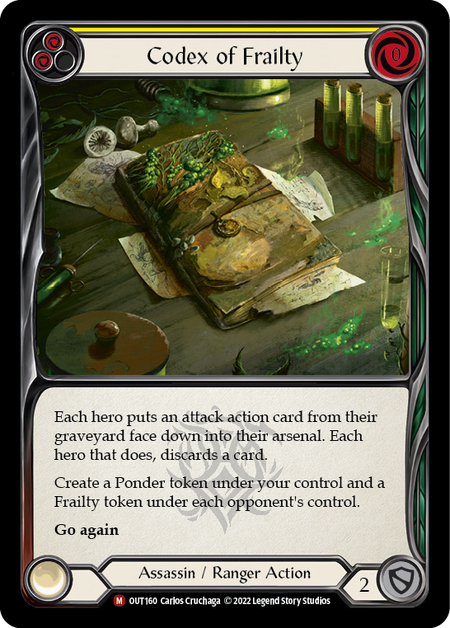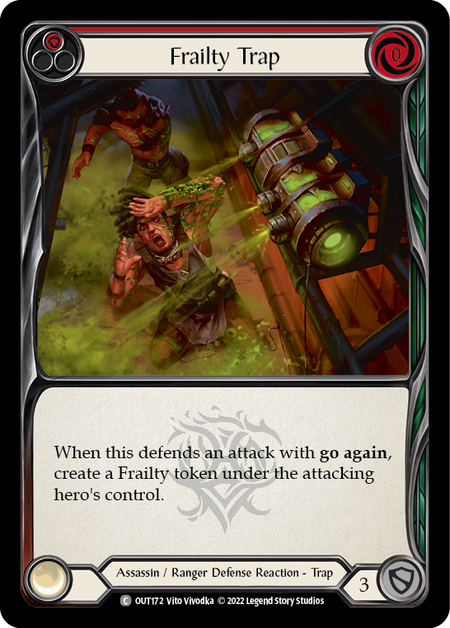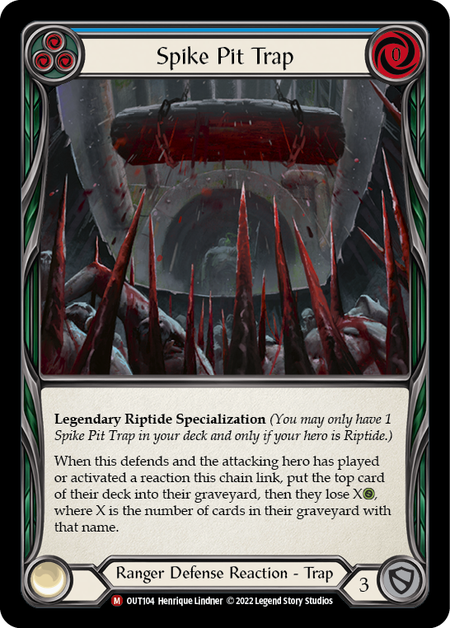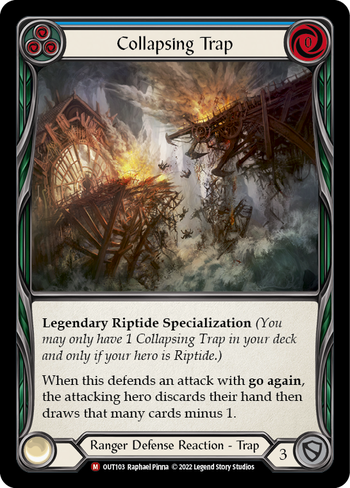The conclusion of the Road to Nationals season has seen an extremely wide range of heroes that have either topped or won their respective local tournaments. And while aggro-type heroes like Brute, Ninja, and Warrior have managed to take the majority of wins collectively, they still seem to struggle into more controlling options that also tend to present damage, like Dromai and Victor. But where Illusionist and Guardians have carved out their placement in the rock/paper/scissors format of the meta, there is always another rogue theory lurking in the depths waiting for your attention.

This RTN season, I took Riptide, Lurker of the Deep to my regional event at Advantage Games in Denver, Colorado. There, I piloted the deck to a modest Top 8 finish, with a loss in top cut to Azalea. Among the 52 players, we had Brodie Spurlock - recent and consistent winner of high level events - and Easton Douglas - famous for his Top 8 finish at Worlds - not to mention other strong local players. I secured Riptide's Top 8 spot early on with four back-to-back wins, and I’m not ashamed to say I strategically fell into my own trap in my last round before top cut to avoid being paired into Easton Douglas' Kano - a matchup I wholly accept as a loss for this list.
With context and pretext out of the way, let’s discuss the master of traps and my build on the new king of fatigue.

Weapons
- Dreadbore (1)
Equipment
- Bull's Eye Bracers (1)
- Arcanite Skullcap (1)
- Perch Grapplers (1)
- Fyendal's Spring Tunic (1)
- Quiver of Abyssal Depths (1)
Loadout
- Battering Bolt (Red) (3)
- Enlightened Strike (Red) (3)
- Collapsing Trap (Blue) (1)
- Buzzsaw Trap (Blue) (1)
- Codex of Frailty (Yellow) (3)
- Frailty Trap (Red) (3)
- Remembrance (Yellow) (3)
- Death Touch (Red) (3)
- Salvage Shot (Red) (1)
- Boulder Trap (Yellow) (3)
- Give and Take (Red) (3)
- Tripwire Trap (Red) (3)
- Command and Conquer (Red) (3)
- Sink Below (Red) (3)
- Pitfall Trap (Yellow) (3)
- Inertia Trap (Red) (3)
- Pendulum Trap (Yellow) (3)
- Remorseless (Red) (3)
- Plague Hive (Yellow) (1)
- Rockslide Trap (Blue) (3)
- Salvage Shot (Yellow) (3)
- Sleep Dart (Red) (3)
- Sleep Dart (Yellow) (3)
- Endless Arrow (Red) (3)
- Fyendal's Fighting Spirit (Red) (3)
- Spike Pit Trap (Blue) (1)
- Standing Order (Red) (3)
- Tarpit Trap (Yellow) (3)
Ranger, as a class, is plagued by a fundamental flaw. While their attacks are powerful and filled with on-hits, they can be blocked out and lose to any respectable deck that chooses to run a suite of defense reactions or a full stack of cards into it, as the stack of cards that make up a Ranger's deck are a resource and on-hits don’t matter if the Ranger can’t swing anymore. To combat this previously-established notion, I set out to build what I believe to be the fundamental answer to stopping fatigue for Rangers: what if we did it ourselves? Included in my list is a series of cards both assisting in fatiguing my opponent and countering fatigue itself: Give and Take, Codex of Frailty, Salvage Shot, Endless Arrow, and Battering Bolt.



Editor's Note: The concept of Fatigue Riptide was posited by Talon Stradley in an earlier piece here at the Rathe Times - and yet the decklists proposed by Rogue and Talon take the concept in very different directions. It's fascinating to see how much variation exists within a single archetype, and lends credence to the notion that Riptide may just be built for this sort of approach.
It started as a pressure test. A simple question: What would happen if I ran 9 Salvage Shots and built a deck to support it?
by: Talon Stradley


To successfuly combat any player who attempts to run the classic counter-fatigue package of a full stack of cards or three Remembrances, I choose to run three myself, along with the Quiver of Abyssal Depths, which acts as a pseudo-Remembrance. My preferred targets for such recycling effects are my greatest weapons that grant me the win condition in long extended games.

Give and Take can produce an infinite attack loop of placing another copy of Give and Take back on top of the deck. This often leads to one of two outcomes: a full fatigue by my opponent, or them leaking 3 damage on each subsequently-recycled swing.
Codex of Frailty provides me the occasional line to force a discard from my opponent and lead to continued arsenal disruption through multiple uses of Command and Conquer; in the worst cases, it still acts as its own Remembrance.

Finally, arrows like Salvage Shot, Endless Arrow, and Battering Bolt ensure that Riptide always comes out on top, as they demand 2-card blocks to prevent their fatigue-friendly strategies - an either-way-you-win outcome, when your goal is to run them out of cards.
If you happen to play Riptide yourself, you may note that I'm not running Trench of Sunken Treasure. Most deck lists you’ll see choose the Trench for its ability to unclog your arsenal and allow Riptide to manage a continued onslaught of arrows. Personally, I find the notation fundamentally flawed in a fatigue deck. Fyendal's Spring Tunic provides much more throughout the game, since the point of the deck is to go through many turn cycles.



Thanks to Riptide's hero ability, trap damage is an ever-present threat. This is the exact reason why I choose to run all copies of the Crucible of War traps, as the unstoppable damage means that all heroes essentially start at Kano’s low 30 health - and in the case of some heroes like Kassai, they start even lower as every trap has the potential to trigger. Chip damage is a recurring theme here; we equip Dreadbore to more consistently reach 4+ damage while sidestepping their defense reactions. By pressing 4s at them repeatedly and cutting off defense reactions from hand, we force the opponent to overblock or accept the small amount of damage bleeding through - and the hit effects that come with that. And once again, either way, Riptide wins.

Some opponents could attempt to catch this list off guard by holding back on attacks and forcing Riptide to be stuck on a trap in arsenal while setting up bigger combo turns - but Riptide is prepared for that, thanks to a healthy count of non-arrow attacks. Standing Order, in particular, is a key card that frees traps from his arsenal. Additionally, it's worth noting that you can pitch to Dreadbore even when you don't have an open arsenal slot; oftentimes I’ll do that when I'm playing out Codex of Frailty so I can avoid the forced discard and float resources so I can swing a Command and Conquer or Fyendal’s Fighting Spirit from my graveyard.


If I haven’t convinced you yet, let me discuss two matchups you’d probably consider auto-loss without a little bit more guidance. The famous Slab Dash is capable of tanking out opponents, and probably seems like the counter to this deck; however, as Dash’s fatigue requires searching out Induction Chambers and Plasma Purifiers, she's vulnerable to fatigue herself. Pendulum Trap and Spike Pit Trap are both capable of responding to Induction Chamber’s effect to give Teklo Pistol go again; thanks to this - and more obvious cards like Frailty Trap and Collapsing Trap - Riptide is gifted with a good chance to mill 8-11 cards from Dash’s deck and deal a significant amount of damage with each effect that triggers.




When playing against illusionist, I choose to cut down my deck to a lean 60 cards - primarily due to a need to see poppers as often as possible, but also to reduce and cut copies of excess trap cards that have the potential to be stuck in arsenal. When playing into Dromai, it’s important to note that you should resist the urge to arsenal a trap, and thanks to my build that denies itself the Trench of Sunken Treasure, you need to be extremely cautious of losing to a well-timed Themai that’ll lock your arsenal's use. Personally, I tend to find success in this matchup, as I eliminate my opponent’s dragons exclusively before I ever proceeding to attacking them. This gives my list’s recursive arrows a chance to shine while Dromai’s deck total dwindles and eventually dies out.
I sincerely hope you give Riptide a try, as his playstyle and points of interaction are wholly unique. As a former Yugioh youtuber and player myself, I can't resist quoting Kiaba when I see my opponent’s despair at their inevitable fate. “Draw your last pathetic card, Yugi!”





